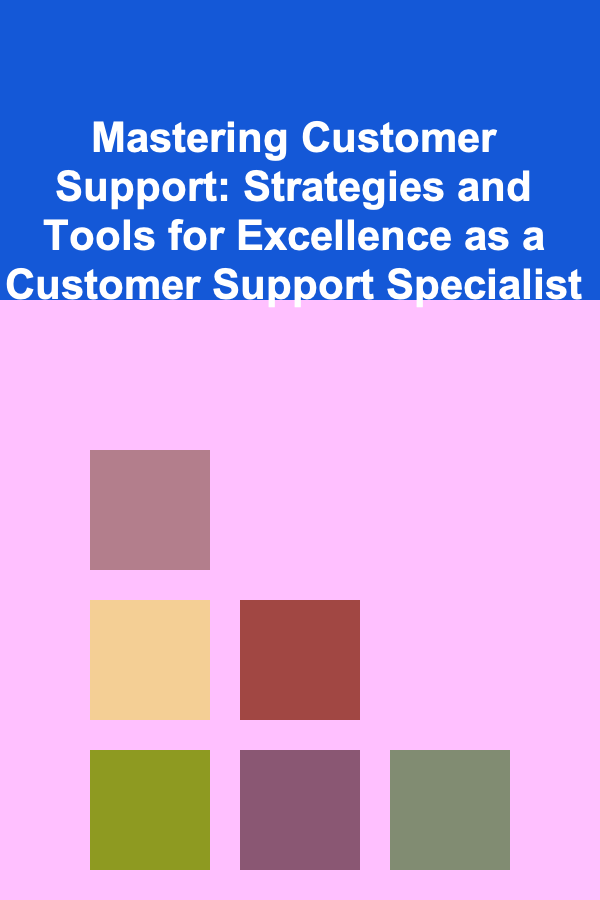
How to Plan a Graphic Design Project from Start to Finish
ebook include PDF & Audio bundle (Micro Guide)
$12.99$9.99
Limited Time Offer! Order within the next:

Graphic design projects, whether they're for a brand, product, event, or campaign, are highly dynamic and require meticulous planning to ensure success. From initial concept to final deliverable, the process involves multiple stages, collaboration, and adjustments. Each design project is unique, but the fundamental principles of effective planning apply universally.
Planning a graphic design project effectively is crucial because it sets the foundation for the entire creative process. It helps designers and clients align on goals, manage expectations, and achieve outcomes that resonate with the target audience. In this article, we will break down the steps involved in planning a graphic design project, providing tips and guidance for each phase.
Understanding the Brief
The first and most crucial step in any graphic design project is thoroughly understanding the project brief. The brief serves as a roadmap, outlining the project's objectives, target audience, deliverables, deadlines, and constraints.
Key Questions to Ask:
- What is the goal of this project? Understand whether the design aims to inform, persuade, entertain, or build brand recognition.
- Who is the target audience? Knowing who the design is for will help tailor the visual style, tone, and messaging.
- What are the key deliverables? Clarify what assets are needed: logos, brochures, posters, web designs, etc.
- What are the deadlines? Establish both internal and client-facing deadlines.
- What are the design requirements? Are there any specific color schemes, fonts, or brand guidelines to follow?
Taking the time to ask these questions ensures that you have a comprehensive understanding of the project's scope and that you can proceed confidently into the next stages.
Research and Inspiration
Once the project brief is clear, the next phase is research. In this step, you explore the market, competitors, design trends, and inspiration to gather ideas that will help inform your design choices.
Steps for Research:
- Analyze Competitors: Look at what others in the industry are doing. What are their design strengths? What can you do differently or better?
- Explore Design Trends: Stay current with design trends that could help make your project feel modern and fresh. However, don't follow trends blindly---ensure they align with the project's goals.
- Review Branding Guidelines: If the project involves an existing brand, review the brand guidelines carefully to ensure consistency in color, typography, and tone.
- Seek Inspiration: Visit design websites, such as Behance, Dribbble, and Pinterest, to gather inspiration. This doesn't mean copying but rather understanding different styles, layouts, and compositions.
Research is about expanding your design toolbox and getting a clear sense of the direction your project should take.
Conceptualization and Sketching
With research and inspiration in hand, you can begin brainstorming and conceptualizing your ideas. This phase is where creativity takes the spotlight, and you begin to translate your research into actual design concepts.
Steps to Follow:
- Brainstorm Ideas: Start by jotting down ideas, creating mood boards, or mind maps. Don't worry about perfection at this stage---focus on generating a wide range of ideas.
- Sketching: Create quick, rough sketches to visualize different compositions, layouts, and arrangements. Sketching allows you to experiment with structure without committing to detailed work.
- Refine Your Concepts: Once you have a few strong concepts, begin refining them by adding more detail and experimenting with typography, color, and shape.
It's essential to give yourself time and space to explore different options during this stage. In the next phase, you'll narrow down your ideas.
Developing the Design
After selecting a promising concept, it's time to start developing it into a more refined design. This stage is where you transition from rough sketches to polished, detailed work. The design should begin to take shape, with the final look starting to emerge.
Key Tasks:
- Create Digital Mockups: Using design software like Adobe Photoshop, Illustrator, or InDesign, create digital versions of your concepts. Use vector-based programs for scalability, especially for logos and illustrations.
- Incorporate Feedback: If you have a team or client involved, share your initial designs and gather feedback. Collaboration can help you see things from different perspectives and improve your work.
- Typography and Color: Fine-tune typography choices and color palettes. Make sure they align with the project's tone and the brand's identity.
- Ensure Consistency: Ensure that the design is consistent across different formats and media. For instance, if designing a logo, it should work in black and white, full color, and be scalable for different uses.
This stage requires attention to detail and a solid understanding of design principles. Take your time to perfect the design without rushing the process.
Client Review and Feedback
Once your design is developed, it's time to present it to the client or stakeholders for feedback. This is often one of the most critical stages in the project, as it helps ensure that the design meets the client's expectations and requirements.
Best Practices for Client Review:
- Present Multiple Options: Rather than presenting just one design, offer a few options. This allows clients to choose the direction they like most and offers more room for discussion.
- Be Prepared to Explain Your Design: Clients may not always understand your design choices. Be ready to explain your reasoning behind color choices, typography, and layout decisions.
- Take Notes: Actively listen to the client's feedback and take detailed notes. Understand what they like and what needs to be revised.
- Don't Take It Personally: Design is subjective, and clients may request changes. Stay professional and use feedback constructively to refine your work.
At this stage, revisions are often necessary to fine-tune the design and ensure it aligns with the client's vision.
Revisions and Refining the Design
Based on the client's feedback, revisions are inevitable. It's crucial to approach this phase with patience and precision. The goal is to polish the design while still staying true to the project's objectives.
Steps to Handle Revisions:
- Prioritize Feedback: Organize the feedback into what's essential and what's optional. Focus on key changes that will significantly impact the design.
- Stay Consistent: Revisions should not compromise the integrity of the design. Keep the core concepts intact while addressing the client's concerns.
- Test Variations: Experiment with alternative color schemes, layouts, or type treatments to see which revisions work best.
- Iterate: Don't expect perfection on the first revision. It may take multiple rounds of tweaks to get the design just right.
The revision stage is about fine-tuning and perfecting the design until both the client and designer are happy with the final result.
Preparing for Delivery
Once the design is approved, it's time to prepare the final files for delivery. The way you prepare and deliver your design is crucial to ensuring it is used properly by the client.
Considerations for Delivery:
- File Formats: Provide the design in multiple formats, including AI, PSD, PNG, JPG, and PDF, depending on the project's needs. For print, ensure high-resolution files; for web, offer optimized versions.
- Brand Guidelines: If applicable, create a set of brand guidelines that outline the correct usage of the design elements (e.g., logo, fonts, colors).
- Backup Files: Keep a backup of all design files in case the client needs additional changes or if the project requires future updates.
- Final Review: Double-check your final files to ensure there are no errors before sending them out.
Properly preparing and organizing your files ensures the client can use the design effectively and reduces any potential confusion down the line.
Post-Delivery Follow-Up
The completion of the design project doesn't always end with the delivery. A post-delivery follow-up is an excellent opportunity to ensure that everything is working as expected.
Actions to Take:
- Check Usage: Follow up to see if the client is using the design as intended. Are there any adjustments needed for different mediums or applications?
- Request Feedback: Ask for feedback on the overall process. What went well, and what could be improved?
- Offer Additional Services: If appropriate, offer ongoing support or design services for future needs, such as creating promotional materials or updating the design.
A follow-up can build strong client relationships and set the stage for future projects.
Conclusion
Effective planning and execution are key to a successful graphic design project. By understanding the project brief, conducting thorough research, developing creative concepts, and working closely with clients through the revision process, you can ensure that the final design meets the project's goals and exceeds client expectations. With careful attention to detail, clear communication, and strategic planning, you can navigate each stage of the design process with confidence and deliver stunning designs that leave a lasting impact.
Reading More From Our Other Websites
- [Home Pet Care 101] How to Teach Your Pet Good Bathroom Habits at Home
- [Soap Making Tip 101] Beyond the Classroom: Turning Your Soap-Making Hobby Into a Small Business
- [Home Lighting 101] How to Use Large Glass Pendant Lights to Define Your Kitchen Space
- [Home Maintenance 101] How to Maintain Your Home's Flooring Based on Material Type
- [Home Storage Solution 101] How to Maximize Storage in a Small Kitchen with Clever Solutions
- [Biking 101] How to Keep Your Bike in Top Shape with Regular Maintenance
- [Home Lighting 101] How to Decorate with LED Strip Lights for a Modern Look
- [Home Lighting 101] How to Incorporate Dimmers into Your Home Lighting Design
- [Home Cleaning 101] How to Clean Your Hardwood Floors Without Damaging Them
- [Hiking with Kids Tip 101] Fun Training Exercises to Build Confidence and Stamina in Kids Before Their First Hike

How to Store Shoes and Accessories Without Creating Clutter
Read More
Mastering Customer Support: Strategies and Tools for Excellence as a Customer Support Specialist
Read More
How to Understand the Role of Fiber in Weight Loss
Read More
How To Understand Cooperative Storytelling Games
Read More
Mastering Healthy Lunch Ideas: A Comprehensive Guide
Read More
How to Build a Pilates To-Do List for Back Pain Relief
Read MoreOther Products

How to Store Shoes and Accessories Without Creating Clutter
Read More
Mastering Customer Support: Strategies and Tools for Excellence as a Customer Support Specialist
Read More
How to Understand the Role of Fiber in Weight Loss
Read More
How To Understand Cooperative Storytelling Games
Read More
Mastering Healthy Lunch Ideas: A Comprehensive Guide
Read More